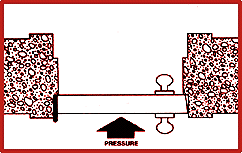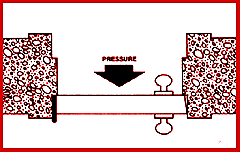3 January 1998
Source:
http://www.overly.com/door/blast/bmono/index.html
Overly Manufacturing Company
Blast Resistant Doors Monograph
Overview
 Ever since the invention of gunpowder we've had to worry
about adequate protection against devastating blasts. No matter whether the
blasts were accidental-from contact of the tiniest spark with some volatile
material-or part of a controlled series of research-associated or
production-associated operations, the tragic loss of lives and facilities
simply had to be reduced.
Ever since the invention of gunpowder we've had to worry
about adequate protection against devastating blasts. No matter whether the
blasts were accidental-from contact of the tiniest spark with some volatile
material-or part of a controlled series of research-associated or
production-associated operations, the tragic loss of lives and facilities
simply had to be reduced.
 Except for its staggering results, very little was known
about the nature of explosions until the mid 1950's. Now we know a great
deal, and we learn more every day it seems. There's a growing mountain of
knowledge about the reaction of various materials under various situations;
an entire generation of engineers has specialized in developing means for
securing adequate protection; today it is possible to drastically reduce
loss of life and damage to facilities under blast conditions.
Except for its staggering results, very little was known
about the nature of explosions until the mid 1950's. Now we know a great
deal, and we learn more every day it seems. There's a growing mountain of
knowledge about the reaction of various materials under various situations;
an entire generation of engineers has specialized in developing means for
securing adequate protection; today it is possible to drastically reduce
loss of life and damage to facilities under blast conditions.
 But sadly, the new knowledge and ability has grown more
rapidly than the awareness that it exists. So we see hazardous facilities
being designed even today without safety provisions which could have been
incorporated easily and at relatively little expense.
But sadly, the new knowledge and ability has grown more
rapidly than the awareness that it exists. So we see hazardous facilities
being designed even today without safety provisions which could have been
incorporated easily and at relatively little expense.
 Now a discussion of blast resistant doors becomes unavoidably
technical, and there are a few items and concepts one doesn't encounter everyday.
But when explosions can be expected to occur in a facility there is no way
to secure adequate protection without incorporating state-of-the-art equipment,
so it is important for designers to understand the basics of today's protection.
Now a discussion of blast resistant doors becomes unavoidably
technical, and there are a few items and concepts one doesn't encounter everyday.
But when explosions can be expected to occur in a facility there is no way
to secure adequate protection without incorporating state-of-the-art equipment,
so it is important for designers to understand the basics of today's protection.
 For instance, the first and most important criterion of
blast resistant door design is to determine whether one really has a blast
resistant door application. Lets' talk about that for a moment.
For instance, the first and most important criterion of
blast resistant door design is to determine whether one really has a blast
resistant door application. Lets' talk about that for a moment.
 The terms "blast resistant door" and "pressure resistant
door" are used sometimes as though they were synonymous, which they are not.
Each is a separate design task and warrants being treated as such. To specify
a blast resistant door where a pressure resistance door is required, or vice
versa, can be extremely hazardous.
The terms "blast resistant door" and "pressure resistant
door" are used sometimes as though they were synonymous, which they are not.
Each is a separate design task and warrants being treated as such. To specify
a blast resistant door where a pressure resistance door is required, or vice
versa, can be extremely hazardous.
Pressure Resistant Doors
 A typical example of a pressure resistant door application
is found in an air lock where negative or positive air pressure exists for
control purposes such as in a clean room. A pressure resistant door is normally
defined as:
A typical example of a pressure resistant door application
is found in an air lock where negative or positive air pressure exists for
control purposes such as in a clean room. A pressure resistant door is normally
defined as:
 "A door where a positive or negative pressure load (above
or below atmospheric pressure) is applied over a long duration (expressed
in seconds, minutes, or longer), and where the pressure loading decay (is
removed from the door) over a long duration."
"A door where a positive or negative pressure load (above
or below atmospheric pressure) is applied over a long duration (expressed
in seconds, minutes, or longer), and where the pressure loading decay (is
removed from the door) over a long duration."
 With durations of such length the loads can be considered
static, and the doors can be designed accordingly. The dynamic response of
the door is not considered for this type of loading.
With durations of such length the loads can be considered
static, and the doors can be designed accordingly. The dynamic response of
the door is not considered for this type of loading.
 If the door is positioned so that the pressure loading
acts to seat the door into the frame against the stops, no consideration
need be given to the hardware other than it be sufficient to support the
weight and size of the door.
If the door is positioned so that the pressure loading
acts to seat the door into the frame against the stops, no consideration
need be given to the hardware other than it be sufficient to support the
weight and size of the door.
 However, if the pressure acts to unseat the door away from
the stops, then the hardware must be capable of resisting all loads imposed
by the pressure as well as radial and thrust loads. This is an important
consideration in the design of both pressure resistant and blast resistant
doors, and it has lead to the design of special hinges and locking devices.
However, if the pressure acts to unseat the door away from
the stops, then the hardware must be capable of resisting all loads imposed
by the pressure as well as radial and thrust loads. This is an important
consideration in the design of both pressure resistant and blast resistant
doors, and it has lead to the design of special hinges and locking devices.
 Blast resistant doors, on the other hand, are normally
designed to resist a high pressure shock front of very short durations (expressed
in milliseconds) which expands outward from the center of the detonation,
with intensity of the pressures decaying with distance and as a function
of time: The exception to this is for nuclear blasts where long durations
(in seconds) are common.
Blast resistant doors, on the other hand, are normally
designed to resist a high pressure shock front of very short durations (expressed
in milliseconds) which expands outward from the center of the detonation,
with intensity of the pressures decaying with distance and as a function
of time: The exception to this is for nuclear blasts where long durations
(in seconds) are common.
 When a detonation occurs, there is a violent release of
energy in a gaseous medium. This gives rise to a sudden pressure increase
in that medium . The pressure disturbance is termed a "blast wave", and it
is characterized by an almost instantaneous rise from the normal or "ambient"
pressure to what we call a "peak incident over-pressure".
When a detonation occurs, there is a violent release of
energy in a gaseous medium. This gives rise to a sudden pressure increase
in that medium . The pressure disturbance is termed a "blast wave", and it
is characterized by an almost instantaneous rise from the normal or "ambient"
pressure to what we call a "peak incident over-pressure".
 This pressure increase - or "shock front" - travels rapidly
from the burst point with a velocity which will be diminishing but which
will remain in excess of sonic velocity of the gaseous medium.
This pressure increase - or "shock front" - travels rapidly
from the burst point with a velocity which will be diminishing but which
will remain in excess of sonic velocity of the gaseous medium.
 The nature of the shock wave varies according to several
factors, not the least of which derive from the type of "burst" experienced.
We can classify the bursts into "free air bursts", "air bursts", "surface
bursts", "partially confined", and "confined". In all types of bursts the
door will be engulfed by the shock pressures as the wave front impinges on
the structure. The magnitude and distribution of the blast loads on the door,
rising from these pressures, are a function of the explosive properties.
The nature of the shock wave varies according to several
factors, not the least of which derive from the type of "burst" experienced.
We can classify the bursts into "free air bursts", "air bursts", "surface
bursts", "partially confined", and "confined". In all types of bursts the
door will be engulfed by the shock pressures as the wave front impinges on
the structure. The magnitude and distribution of the blast loads on the door,
rising from these pressures, are a function of the explosive properties.
These consist of:
a. Type of explosive material;
b. Its energy output;
c. Weight of the explosive;
d. Location of the explosive relative to the door.
The blast wave pressure is also increased due to reflection and reinforcement
by its interaction with the ground area or the structure in which the door
is installed.
Free Air Bursts
 When a detonation occurs adjacent to - and above - a protective
structure, and so near that no amplification of the initial shock wave occurs
between the explosion source and the door, then the blast loadings acting
on the door are defined as "Free air burst blast pressures".
When a detonation occurs adjacent to - and above - a protective
structure, and so near that no amplification of the initial shock wave occurs
between the explosion source and the door, then the blast loadings acting
on the door are defined as "Free air burst blast pressures".
 As the pressure wave moves radically away from the center
of the explosion, it contacts the door and - upon contact - the initial wave
pressures are reinforced and reflected.
As the pressure wave moves radically away from the center
of the explosion, it contacts the door and - upon contact - the initial wave
pressures are reinforced and reflected.
 The variation of the pressure on the door surface is a
function of the "angle of incidence": The angle of incidence is formed by
a line which defines the normal distance between the point of detonation
and the door, and a line which defines the path of shock propagation between
the center of the explosion and any other point of the structure in which
the door is located.
The variation of the pressure on the door surface is a
function of the "angle of incidence": The angle of incidence is formed by
a line which defines the normal distance between the point of detonation
and the door, and a line which defines the path of shock propagation between
the center of the explosion and any other point of the structure in which
the door is located.
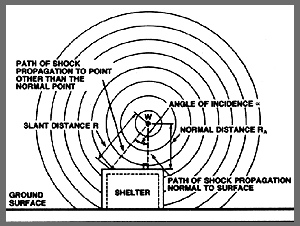
Air Bursts
 An "air burst" blast environment is produced by detonations
which occur above the ground surface and at some distance away from the door,
so that the initial shock wave propagating away from the explosion impinges
on the ground surface prior to its arrival at the door.
An "air burst" blast environment is produced by detonations
which occur above the ground surface and at some distance away from the door,
so that the initial shock wave propagating away from the explosion impinges
on the ground surface prior to its arrival at the door.
 As the blast wave continues to propagate outward, a front
known as the "mach front" is formed by the interaction of the initial wave
and a reflected wave which resulted from reinforcement of the incident wave
by the ground. The height of the mach front increases as the wave propagates
away from the center of the detonation. This increase in height is referred
to as the path of the triple point and is formed by the intersection of the
initial reflected and mach waves. A structure is subjected to a plane wave
(uniform pressure) when the height of the triple point exceeds the height.
As the blast wave continues to propagate outward, a front
known as the "mach front" is formed by the interaction of the initial wave
and a reflected wave which resulted from reinforcement of the incident wave
by the ground. The height of the mach front increases as the wave propagates
away from the center of the detonation. This increase in height is referred
to as the path of the triple point and is formed by the intersection of the
initial reflected and mach waves. A structure is subjected to a plane wave
(uniform pressure) when the height of the triple point exceeds the height.
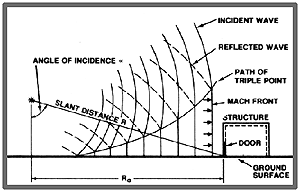
Surface Burst
 A charge located on the ground surface - or very near to
it - is considered to be a "surface burst".
A charge located on the ground surface - or very near to
it - is considered to be a "surface burst".
 In a surface burst, the initial wave of the explosion is
reflected and reinforced by the ground surface to produce a reflected wave.
Unlike the air burst, the reflected wave merges with the incident wave at
the point of detonation. This forms a single wave similar in nature to the
reflected wave of the air burst, but essentially hemispherical in shape.
In a surface burst, the initial wave of the explosion is
reflected and reinforced by the ground surface to produce a reflected wave.
Unlike the air burst, the reflected wave merges with the incident wave at
the point of detonation. This forms a single wave similar in nature to the
reflected wave of the air burst, but essentially hemispherical in shape.
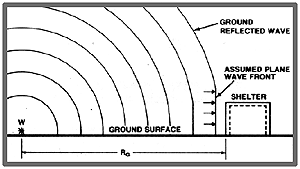
Partially Confined Explosions
 When an explosion occurs within a structure , the peak
pressures associated with the initial shock front are extremely high and
are amplified by their reflections within the structure. Additionally, the
accumulation of gasses from the explosion exert more pressure and they increase
the load duration within the structure. The combined effects of both pressures
can destroy a structure unless adequate venting is provided.
When an explosion occurs within a structure , the peak
pressures associated with the initial shock front are extremely high and
are amplified by their reflections within the structure. Additionally, the
accumulation of gasses from the explosion exert more pressure and they increase
the load duration within the structure. The combined effects of both pressures
can destroy a structure unless adequate venting is provided.
 The use of cubical type structures with one or more surfaces
either sufficiently frangible or open to atmosphere will normally provide
adequate venting. This type of structure permits a blast wave from an internal
explosion to spill over onto the exterior ground surface in a condition known
as "leakage pressure".
The use of cubical type structures with one or more surfaces
either sufficiently frangible or open to atmosphere will normally provide
adequate venting. This type of structure permits a blast wave from an internal
explosion to spill over onto the exterior ground surface in a condition known
as "leakage pressure".
 Exterior, or leakage pressure loads result when the detonation
occurs near the ground surface and behind an obstruction which interferes
with the shock wave before it reaches the door.
Exterior, or leakage pressure loads result when the detonation
occurs near the ground surface and behind an obstruction which interferes
with the shock wave before it reaches the door.
 Interior, or high pressure loads result when the detonation
is located within - or immediately adjacent to - a structure, and blast pressures
are amplified due to multiple reflections by the structure as a result of
its closeness to the explosion. The pressures reflected and reinforced within
the structure are referred to as "interior shock front pressures", while
those pressures accumulated from the gaseous products of the explosions are
identified as "gas pressures".
Interior, or high pressure loads result when the detonation
is located within - or immediately adjacent to - a structure, and blast pressures
are amplified due to multiple reflections by the structure as a result of
its closeness to the explosion. The pressures reflected and reinforced within
the structure are referred to as "interior shock front pressures", while
those pressures accumulated from the gaseous products of the explosions are
identified as "gas pressures".
 The term "frangible" pertains to those elements of a structure
whose strength and mass or anchorage are sufficiently weak to minimize the
amplification of the shock front pressures and reduce confinement of the
explosive gases by breaking up, falling away, or opening slightly to provide
relief from pressure.
The term "frangible" pertains to those elements of a structure
whose strength and mass or anchorage are sufficiently weak to minimize the
amplification of the shock front pressures and reduce confinement of the
explosive gases by breaking up, falling away, or opening slightly to provide
relief from pressure.
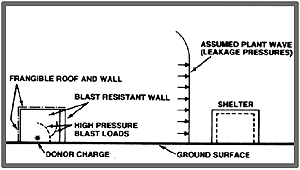
Unconfined Explosions
 We previously defined free air bursts, air bursts, and
surface bursts. Of those categories, air bursts are seldom encountered and
a free air burst is the least likely to occur.
We previously defined free air bursts, air bursts, and
surface bursts. Of those categories, air bursts are seldom encountered and
a free air burst is the least likely to occur.
 Free air burst loads: For this type loading the
blast wave propagates away from the center of the explosion, striking the
door without intermediate amplification of the initial shock wave.
Free air burst loads: For this type loading the
blast wave propagates away from the center of the explosion, striking the
door without intermediate amplification of the initial shock wave.
 Air burst loads: For this type loading the explosion
is located at a distance away from and above the door so that the ground
reflections of the initial wave occur before the blast wave reaches the door.
Air burst loads: For this type loading the explosion
is located at a distance away from and above the door so that the ground
reflections of the initial wave occur before the blast wave reaches the door.
 Surface burst loads: For this type loading the explosion
is located close to - or on - the ground so that the shock wave is amplified
at the point of detonation due to ground reflections.
Surface burst loads: For this type loading the explosion
is located close to - or on - the ground so that the shock wave is amplified
at the point of detonation due to ground reflections.
Protection Categories
 Protection afforded by a door and the facility in which
it is installed is subdivided into four protection categories:
Protection afforded by a door and the facility in which
it is installed is subdivided into four protection categories:
 Class A protection: Provides life safety; protects
personnel from fragments, falling portions of a structure or equipment;
attenuates blast pressures and structural motion to a level consistent with
safety requirements.
Class A protection: Provides life safety; protects
personnel from fragments, falling portions of a structure or equipment;
attenuates blast pressures and structural motion to a level consistent with
safety requirements.
 Class B protection: Protects equipment and supplies
from fragment impact, blast pressures, and structural motions; protects against
uncontrolled releases of hazardous materials including toxic chemicals,
radioactive materials, biological materials, and similar items.
Class B protection: Protects equipment and supplies
from fragment impact, blast pressures, and structural motions; protects against
uncontrolled releases of hazardous materials including toxic chemicals,
radioactive materials, biological materials, and similar items.
 Class C protection: Protects against communication
of detonation by fragments and high blast pressures.
Class C protection: Protects against communication
of detonation by fragments and high blast pressures.
 Class D protection: Protects against mass detonations
of explosives as a result of sympathetic detonations produced by communication
of detonation between two adjoining areas.
Class D protection: Protects against mass detonations
of explosives as a result of sympathetic detonations produced by communication
of detonation between two adjoining areas.
Fragmentation
 In some situations, primary fragments from cased explosives
can be, depending upon their mass, the controlling factor in the design of
a blast resistant door. The mass velocity characteristics of the primary
fragments also depend upon the properties of the explosive.
In some situations, primary fragments from cased explosives
can be, depending upon their mass, the controlling factor in the design of
a blast resistant door. The mass velocity characteristics of the primary
fragments also depend upon the properties of the explosive.
 Heavy high velocity primary fragments may penetrate a door,
depending upon its thickness and other characteristics, while lightweight
fragments seldom achieve penetration. However, both light and heavy fragments
may ricochet into protected areas and cause injury to personnel, damage
equipment, or detonation of other explosives.
Heavy high velocity primary fragments may penetrate a door,
depending upon its thickness and other characteristics, while lightweight
fragments seldom achieve penetration. However, both light and heavy fragments
may ricochet into protected areas and cause injury to personnel, damage
equipment, or detonation of other explosives.
 For protection against primary fragments, a sufficient
structural thickness must be provided to prevent penetration. .
For protection against primary fragments, a sufficient
structural thickness must be provided to prevent penetration. .
Explosive Materials
 Explosive materials are classified according to their physical
state, which consists of solids, liquids, and gasses.
Explosive materials are classified according to their physical
state, which consists of solids, liquids, and gasses.
 Solid explosives are primarily high explosives. However,
other material such as chemicals and propellants also can be classified as
potentially high explosive materials.
Solid explosives are primarily high explosives. However,
other material such as chemicals and propellants also can be classified as
potentially high explosive materials.
 The blast pressure environment produced will vary among
different solid explosive materials, and can also vary for a particular material.
The blast effects of solid materials (which consist of the blast pressure
impulse, durations, and other effects) have been well established and charted
and are often stated as to their equivalence in pounds of TNT.* See Bibliography
notations.
The blast pressure environment produced will vary among
different solid explosive materials, and can also vary for a particular material.
The blast effects of solid materials (which consist of the blast pressure
impulse, durations, and other effects) have been well established and charted
and are often stated as to their equivalence in pounds of TNT.* See Bibliography
notations.
 The explosive properties of such materials determine limitation
of the detonation process and, thereby, result in either high order or low
order detonation. With high order detonation the process is generally compete
and results in a maximum pressure output for any given type and amount of
material. If the detonation is incomplete, a large quantity of explosives
is consumed by deflagration ( a sudden and violent combustion), thus reducing
blast pressure.
The explosive properties of such materials determine limitation
of the detonation process and, thereby, result in either high order or low
order detonation. With high order detonation the process is generally compete
and results in a maximum pressure output for any given type and amount of
material. If the detonation is incomplete, a large quantity of explosives
is consumed by deflagration ( a sudden and violent combustion), thus reducing
blast pressure.
 Unlike high explosive materials, other solid, liquid, and
gaseous explosive materials exhibit variations of their blast pressure output
due to the fact that an explosion of these materials in many instances is
incomplete, with only a portion of the total mass involved in the detonation
process. The remainder of the mass usually is consumed by deflagration with
a large amount of the material's energy being dissipated in thermal energy.
Unlike high explosive materials, other solid, liquid, and
gaseous explosive materials exhibit variations of their blast pressure output
due to the fact that an explosion of these materials in many instances is
incomplete, with only a portion of the total mass involved in the detonation
process. The remainder of the mass usually is consumed by deflagration with
a large amount of the material's energy being dissipated in thermal energy.
Designing Blast Resistant Doors
 Now if all this information seems complicated and confusing
it's because the entire task of designing a blast resistant door system is
complicated and confusing. And if the topics discussed appear to warrant
much deeper discussion, it's because a complete treatise on blast resistant
door systems would fill many volumes.
Now if all this information seems complicated and confusing
it's because the entire task of designing a blast resistant door system is
complicated and confusing. And if the topics discussed appear to warrant
much deeper discussion, it's because a complete treatise on blast resistant
door systems would fill many volumes.
 There is no such thing as a "stock or standard" blast resistant
door, simply because there are no stock blast situations to protect against.
Each installation invariably presents new challenges, new parameters of explosive
and distance, and combined hazards from inside and out. True expertise in
designing successful blast resistant door systems derives only from years
of experience and considerable special training for the entire design/build
team.
There is no such thing as a "stock or standard" blast resistant
door, simply because there are no stock blast situations to protect against.
Each installation invariably presents new challenges, new parameters of explosive
and distance, and combined hazards from inside and out. True expertise in
designing successful blast resistant door systems derives only from years
of experience and considerable special training for the entire design/build
team.
 The variables are so numerous that highly sophisticated
computer programs are used today to arrive at practical solutions. And only
the most competent and qualified specialists can be expected to turn the
solutions into operating reality. Since these solutions frequently impinge
on other structural components of a facility, it is wise to tackle preliminary
design of the blast resistant door systems early in the design stage of any
project where their need will exist.
The variables are so numerous that highly sophisticated
computer programs are used today to arrive at practical solutions. And only
the most competent and qualified specialists can be expected to turn the
solutions into operating reality. Since these solutions frequently impinge
on other structural components of a facility, it is wise to tackle preliminary
design of the blast resistant door systems early in the design stage of any
project where their need will exist.
 While blast resistant door systems may be required in many
high technology industrial buildings, as well as military applications, project
designers of those buildings cannot be expected to have the specialized knowledge
needed to completely plan for an adequate blast resistant installation. So
it is important to establish an early relationship with a reputable blast
resistant door manufacturer to avoid expensive redesigns and project delays.
While blast resistant door systems may be required in many
high technology industrial buildings, as well as military applications, project
designers of those buildings cannot be expected to have the specialized knowledge
needed to completely plan for an adequate blast resistant installation. So
it is important to establish an early relationship with a reputable blast
resistant door manufacturer to avoid expensive redesigns and project delays.
 Data the manufacturer's will need start with the type and
amount of explosives involved, the type blast to be anticipated, and the
construction in which the blast resistant door systems must be located. These
three are only the starting point; the rest is up to the specialists.
Data the manufacturer's will need start with the type and
amount of explosives involved, the type blast to be anticipated, and the
construction in which the blast resistant door systems must be located. These
three are only the starting point; the rest is up to the specialists.
 But if you want to be truly helpful in design of the door
system, determine all pertinent information needed to fill in the blanks
on the following list. You will speed up the process if you do.
But if you want to be truly helpful in design of the door
system, determine all pertinent information needed to fill in the blanks
on the following list. You will speed up the process if you do.
Questions to be Considered and Answered
1. Is design analysis to be dynamic? _______ or static? ______
2. If static analysis, the maximum blast loading that the door will be subject
to in ______psi
or ______ psf.
3. If dynamic analysis, one of the following combinations of data must be
furnished, using these definitions:
"W" is known load in equivalent pounds, tons, Kton, or Mton of TNT.
"r" is slant distance from the explosion in feet.
"To" is the duration of the positive pressure in seconds or milliseconds.
"Ppfa" is peak free air pressure in psi.
"PsP" is peak incident pressure (reflected pressure in psi).
3.1 W ______, r ______
3.2 W ______, To _______
3.3 W ______, r ______, To ______
3.4 W ______, Ppfa ______, To ______
3.5 To ______, Ppfa ______
3.6 r _______, Ppfa ______
3.7 r _______, Ppfa ______, To ______
3.8 PsP ______, To ______
3.9 PsP ______, r ______
3.10 PsP ______, r ______, To ______
3.11 W ______, Ppfa ______, r ______
4.0 If dynamic analysis, the following data must also be provided:
4.1 Angle of incidence in degrees (if this data not available, assume 0 angle,
which provides maximum pressure).
4.2 If atmospheric blast, specify if air ______ or surface burst _____.
4.3 If continued or partially confined blast, furnish sketch showing dimensions
of room or test cell including height, locations, of door and explosion,
confined gas pressure in psi and duration of gas pressure in seconds ______
or milliseconds.
5.0 The following data is required for either dynamic or static analysis.
5.1 Direction of initial blast force:
5.1.1 To seat door ______
5.1.2 To unseat door ______
5.2 Is plastic (permanent) deformation permitted? (not permitted for static
design).
5.2.1 Ductlilty ratio ______ or
5.2.2 Total permissible deflection ______ or
5.2.3 Degrees of rotation ______
5.3 Allowable elastic deflection ______. Unless otherwise specified, doors
normally are designed with deflection limited to L/60 for all components.
5.4 Door must be designed for 100% rebound pressure when static analysis
is used. For dynamic analysis door will be designed for rebound as determined
by the dynamic response.
6. What level of blast protection is required:
A ______ B______ C______ D______ ?
7. If additional requirements such as fire rating, security, shielding or
acoustical performance are required please list.
Bibliography
1. "Design of Blast Resistant Construction for Atomic Explosions,"
C.S. Whitney, B.G. Anderson and E. Cohen , Journal of the American Concrete
Institution, March, 1955.
2. The Effects of Nuclear Weapons, U.S. Government Printing Office,
Washington, D.C. 1964.
3. Structures to Resist the Effects of Accidental Explosions, Department
of the Army, the Navy and the Air Force, June 1969.
4. Structural Designs for Dynamic Loads, Norris, Hansen, Holley, Biggs,
Namyet and Minami, McGraw-Hill Book Company, Inc. 1959.
5. Formulas for Stress and Strain, 5th Edition, R.J. Roark and W.C.
Young, McGraw-Hill, Inc. 1975.
6. Design of Structures to Resist Nuclear Weapons Effects, American
Society of Civil Engineers, Manual Number 42, 1961.
7. Manual of Steel Construction, 8th Edition, of the American Institute
of Steel Construction.
©Copyright Overly Manufacturing Company
See also Overly's TEMPEST door.
 Ever since the invention of gunpowder we've had to worry
about adequate protection against devastating blasts. No matter whether the
blasts were accidental-from contact of the tiniest spark with some volatile
material-or part of a controlled series of research-associated or
production-associated operations, the tragic loss of lives and facilities
simply had to be reduced.
Ever since the invention of gunpowder we've had to worry
about adequate protection against devastating blasts. No matter whether the
blasts were accidental-from contact of the tiniest spark with some volatile
material-or part of a controlled series of research-associated or
production-associated operations, the tragic loss of lives and facilities
simply had to be reduced.  Except for its staggering results, very little was known
about the nature of explosions until the mid 1950's. Now we know a great
deal, and we learn more every day it seems. There's a growing mountain of
knowledge about the reaction of various materials under various situations;
an entire generation of engineers has specialized in developing means for
securing adequate protection; today it is possible to drastically reduce
loss of life and damage to facilities under blast conditions.
Except for its staggering results, very little was known
about the nature of explosions until the mid 1950's. Now we know a great
deal, and we learn more every day it seems. There's a growing mountain of
knowledge about the reaction of various materials under various situations;
an entire generation of engineers has specialized in developing means for
securing adequate protection; today it is possible to drastically reduce
loss of life and damage to facilities under blast conditions.  But sadly, the new knowledge and ability has grown more
rapidly than the awareness that it exists. So we see hazardous facilities
being designed even today without safety provisions which could have been
incorporated easily and at relatively little expense.
But sadly, the new knowledge and ability has grown more
rapidly than the awareness that it exists. So we see hazardous facilities
being designed even today without safety provisions which could have been
incorporated easily and at relatively little expense.  Now a discussion of blast resistant doors becomes unavoidably
technical, and there are a few items and concepts one doesn't encounter everyday.
But when explosions can be expected to occur in a facility there is no way
to secure adequate protection without incorporating state-of-the-art equipment,
so it is important for designers to understand the basics of today's protection.
Now a discussion of blast resistant doors becomes unavoidably
technical, and there are a few items and concepts one doesn't encounter everyday.
But when explosions can be expected to occur in a facility there is no way
to secure adequate protection without incorporating state-of-the-art equipment,
so it is important for designers to understand the basics of today's protection.
 For instance, the first and most important criterion of
blast resistant door design is to determine whether one really has a blast
resistant door application. Lets' talk about that for a moment.
For instance, the first and most important criterion of
blast resistant door design is to determine whether one really has a blast
resistant door application. Lets' talk about that for a moment.  The terms "blast resistant door" and "pressure resistant
door" are used sometimes as though they were synonymous, which they are not.
Each is a separate design task and warrants being treated as such. To specify
a blast resistant door where a pressure resistance door is required, or vice
versa, can be extremely hazardous.
The terms "blast resistant door" and "pressure resistant
door" are used sometimes as though they were synonymous, which they are not.
Each is a separate design task and warrants being treated as such. To specify
a blast resistant door where a pressure resistance door is required, or vice
versa, can be extremely hazardous.